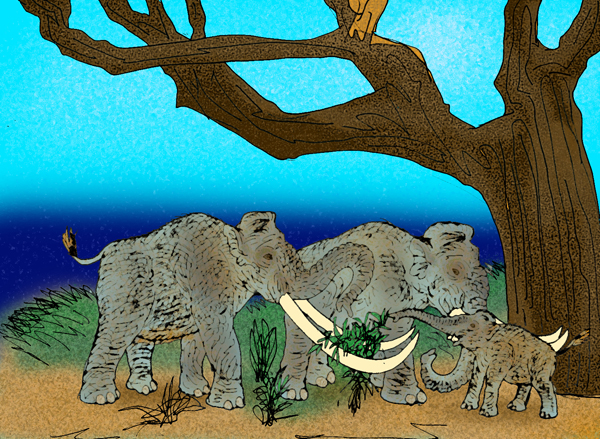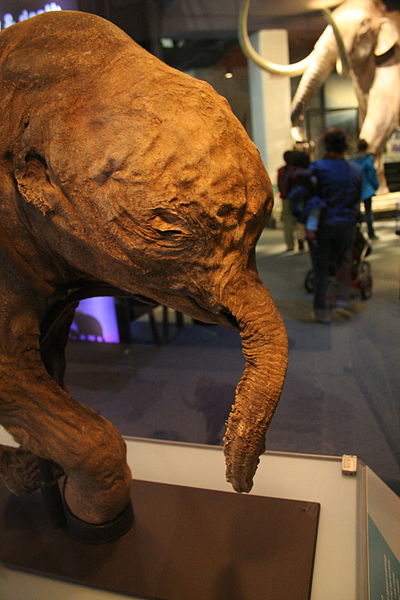Let’s go meta. Recently, ecologist extraordinaire Dr. Jacquelyn Gill (or is it Professor cos of that weird American system?) wrote a wonderful review article on the extinctions that affected many large mammal species during the last 50-10,000 years. This period is known as the Quaternary, and was a time when ice ages were running rife between warmer periods, and herds of enigmatic mammals roamed the steppes. It’s also a time when many wonderful animals, such as mammoths, disappeared from our planet forever, apart from rare fuzzy sightings from drunk Russians that later turn out to be a bear, or nothing. The result is that although we have a spectacular range of mammals decorating our landscapes today, this is but a shadow of mammals’ true splendour back just a few thousand years.

Legit scientific claims (source)
In modern ecosystems, large mammals dominate the structure of ecosystems in a top-down fashion. Serengeti herds can demolish vast swathes of vegetation, and mammals, particularly cervids and bovids may have a cool co-evolutionary history with grasslands. These large animals are known as megaherbivores, and their evolutionary history in the recent geological past can be critical to understanding how future ecosystems will change and function. Just for a bit of context, the last mammoths went extinct in Europe when the ancient Egyptians were getting their pyramid on in Africa, some 4,500 years ago.
But what happens when all the mammoths disappear? What happens when all these wonderful large animals go extinct? I mean, that’s gotta have some serious ecological impacts, right? And the bigger question of trying to answer these questions in the fossil and geological records is, to what extent can we tie correlation and causation, or at least some sort of relationship.
- Fossilised baby mammoth! (source)
One of the issues is with space and time. If we have environmental data from a certain place, to what extent can we correlate that with fossil remains from another. It can be quite easy to mistake a local signal for a regional or global one, and end up trying together two lines from two different stories. Also, to what extent is it possible to tease apart the effects of external environmental factors on biodiversity and extinctions, from effects which might be specific to the organisms, such as their diet or body mass? This is very much an ongoing discussion within the palaeontological literature, and pretty much involves a tonne of statistics. More on this sooooon!
In the time of the megaherbivores, the Quaternary, poop may reveal all. As is one of the many facts of life. Sporormiella is what’s called a coprophilic fungal spore, from a fungus that well, eats poop. One of the coolest things is that because it’s found in poop, and particularly that of mammals, it’s often preserved in places where animals would have lived, making spatial correspondences much more accurate. Sporomiella is cool. In an earlier paper from 2013, Jacquelyn found that the abundance of this poor spore could be directly linked to grazing intensity of bison, so can be really useful in detecting changes in bison populations as well as the food they consumed, which may have environmental causes. Neat eh? The same thing can’t really be done further back in the fossil record, like with dinosaurs, as we just don’t have the accuracy or resolution of data to mimic these kinds of studies.

Did early acupuncture drive the mammoths to extinction..? (source)
But what can all of this cool ecological information and awesome fossily finds tell us about the impacts of the extinction of mammoths and their mammaly co-habitors? Jacquelyn provides several awesome examples in her review. For example, what happens to plants when everything that eat them disappears? Spores are again they key – in North America, a decline in spores is tracked by an increase in the diversity of hardwood plants, perhaps as a direct ecological release mechanism from the extinction of large herbivores. In Australia and Madagascar, decline in these spores as well as pollen also tracks the decline in megafauna following their removal after the last ice age (yes, Australia suffered too!), which suggests that major patterns in vegetation can be driven by megafauna alone, in the absence of climate change.
Fire isn’t something I’d usually consider when discussing ecological interactions, as we don’t really see the evidence of it way back in the Jurassic and Cretaceous. However, fire, in all of its destructive prowess, is actually one of the primary controllers on modern vegetation dynamics. Back when more megafauna dominated our landscapes, there may have been less fire as more herbivores would have meant more effective vegetation recycling (indicated by fossilised charcoal), so would have had an indirect secondary control on plant dynamics.
Jacquelyn goes into more detail about how these extinctions affected things like the ‘patchiness’ of the landscape, biogeochemical cycles (like nitrogen and carbon), the effects on plant dispersal through things like animal-transportation, as well as possible effects on smaller mammal communities. There’s a lot of neat information in there, and it’s worth having a look through and seeing if you can relate any of the changes recorded in the Quaternary to those you’ve either heard of or are happening around you.

Wouldn’t it be great to see this again? 🙂 (source)
A question leading off all of this is what are the effects of modern extinctions going to be on ecological factors such as community composition in both plants and animals, plant and animal interaction and trophic structures, seed dispersal pathways (e.g., via poop), the rates and patterns of nutrient and chemical cycling, as well as things like fire regimes (less of an issue here in the UK). The only we can predict how biodiversity dynamics, including extinction, migration, and speciations are going to affect these crucial things is through studying how they changed in the past. Hopefully, this convinces you to a degree the value of palaeontology and palaeoecology!
I guess the final question is, if we could recreate these ecosystems, and not just the animals that occupied them, would you want to? De-extinction is pretty much a null argument, but what about reconstructing entire biomes, healthy ones, that extinct animals could comfortably adapt to?
Reference: Gill, J. L. (2013) Ecological impacts of late Quaternary megaherbivore extinctions, New Phytologist, 201(4), 1163-1169 (open access link – ta Jacquelyn!) 🙂


Gary Hoyle
Hi Jon,
Fascinating article. I was aware of the existence of mammoths on Wrangle Island up until the time of Egyptian pyramid building, but I had not heard of finds in Europe from that period. Can you give me a little info on those finds?
Back in the early 1990s, I lead an excavation of the remains of a mammoth found in southern Maine, USA. My mammoth expert on the project was Dan Fisher [University of Michigan]. Dan had developed a technique of doing life studies by analyzing ivory growth rings in tusks. Radiocarbon dating for the ivory and molar dentine was 12,200 radiocarbon years – at the post-glacial. Pollen studies established a park-scape of dwarf birch, spruce and fir. In a nutshell our evidence showed an animal under nutritional stress in a rapidly changing environment [essentially supporting Jacquelyn Gill’s work]. What was also interesting was that this female exhibited characteristics of two mammoth species – Mammuthus primigenesis and M. columbi. Both these species had been isolated from each other until the Wisconsinan Ice sheet collapsed.
As a side note, Dan Fisher is still doing life study work, now on the frozen mammoths in Siberia…………Gary
Jon Tennant
Hey Gary,
The last mammoths were apparently on Wrangel Island, some 3700 years BP. If you Google Scholar “mammoth wrangel island”, then quite a few cool results come up!
Hope that helps a bit 🙂
Jon
Bob Goin
I believe dwarf mammoths were found on St. Pauli Island of Alaska dating from the same period as the Wrangel Island mammoths.
Jon Tennant
This one looks like a particularly good paper: http://www.sciencedirect.com/science/article/pii/S0033589408000422
(Thanks to Jacquelyn on Twitter!)